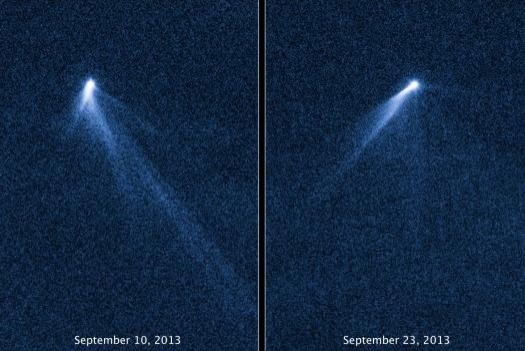‘Freakish’ Asteroid Discovered By NASA Hubble Space Telescope, Has Six Comet-Like Tails [PHOTO]

A six-tailed asteroid described as a “weird and freakish” object by astronomers has been found in an asteroid belt between Mars and Jupiter.
The bizarre asteroid was spotted in August by the Pan-STARRS 1 telescope in Hawaii and was described in the latest issue of the Astrophysical Journal Letters. Unlike other asteroids that appear as tiny points of light, this one had six comet-like tails that look like spokes on a wheel or a lawn sprinkler.
“We were literally dumbfounded when we saw it,” David Jewitt, lead investigator from the University of California at Los Angeles, said in a NASA news release. “Even more amazingly, its tail structures change dramatically in just 13 days as it belches out dust. That also caught us by surprise. It’s hard to believe we’re looking at an asteroid.”
The asteroid, dubbed P/2013 P5, was found in an area known to have a large population of asteroids and is believed to have been ejecting dust for at least five months.
The asteroid’s multiple tails were not seen at first. It was only on Sept. 10 when images of the object captured by NASA's Hubble Space Telescope revealed the six tails. Astronomers are still trying to figure out what caused the tails.
One theory suggests they were formed by a series of "impulsive dust-ejection events." These include heat from the sun’s radiation, which heats up the asteroid’s surface, causing it to “spin up,” also known as the Yarkovsky-O’Keefe-Radzievskii-Paddack (YORP) effect.
If the asteroid began to spin fast enough, its weak gravity would no longer be able to hold the space rock together. Dust would fall off the asteroid and drift into space, forming a tail. And while six tails may seem like a lot, Jewitt says only 100 to 1,000 tons of dust have been lost from the asteroid, which has an estimated 700-foot-radius nucleus.
The P/2013 P5 may look like a comet, but Jewitt insists the evidence suggests it's an asteroid that probably broke apart in a collision 200 million years ago. Not only that, there may be more unusual objects in the same asteroid belt yet to be discovered.
"In astronomy, where you find one, you eventually find a whole bunch more," Jewitt said. "This is just an amazing object to us, and almost certainly the first of many more to come."
© Copyright IBTimes 2024. All rights reserved.






















